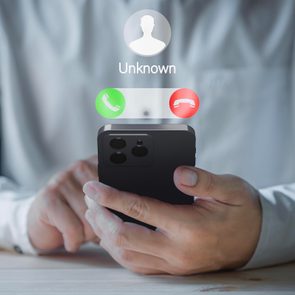Were they busy, out of network or—gulp!—screening your call? Here's how to know if someone declined your call intentionally.

Here’s How to Know if Someone Declined Your Call

You phoned your friend, but the call went to voicemail after one ring. It happens. There could’ve been a network issue, or your pal might not have picked up the phone in time. But how do you know if someone declined your call … on purpose?
The split-second assumption that someone saw your name on the screen and declined your call can sting longer than you’d expect. If this thought sets off your fear of rejection, know you’re not alone. While some Android devices make it slightly more obvious when a call is declined by occasionally displaying a “call declined” label in the call log, Apple devices are notoriously stingy with clues for callers.
If you really want to know whether somebody intentionally rejected your call or simply missed it, you have to look for the signs. With the help of an expert, we’re diving into the must-know tech tips below. Read on to learn how to know if someone declined your call—and potential reasons why you went straight to voicemail.
Get Reader’s Digest’s Read Up newsletter for more tech, travel, cleaning, humor and fun facts all week long.
How do you know if someone declined your call?

Although there’s no foolproof way to know if someone deliberately declined your call, you can look for a few signs. The behaviors below may indicate that the person you’re trying to reach took steps to avoid your call.
It rang once before going to voicemail
If you suspect someone rejected your call, paying attention to the number of rings can clarify your confusion. “The sign that your calls are ignored is how many rings until it goes to voicemail,” says Ben Hartwig, the web operations director at InfoTracer, a company that specializes in public records searches.
He notes that, typically, the ringtone will go through a few cycles until the voicemail message comes up. What happens when someone rejects your call? You reach their voicemail sooner. “If it rings only one or two times and goes to voicemail, then your call is probably declined,” he says. Translation: The person you’re calling manually clicked the “decline” button.
However, this is not always the case. A polite (or sneaky!) person could simply let the phone ring until it naturally sends your call to voicemail, in which case you’ll hear more than one ring even though your call was rejected.
Your texts are undelivered
Undelivered texts could be a sign that the person you’re trying to reach doesn’t have service … or took steps to avoid communication by blocking your number. “Blocked calls are different from declined calls because your phone call never gets to the person you’re trying to reach. This feature is set into the software of almost all cellphone models,” Hartwig says. And, generally speaking, it’s a good thing. Spam callers can’t ring you at all hours of the day if you block them—and neither can your ex.
However, if you end up on someone’s blocked-caller list, you won’t even make it to the declined-call stage. So how do you know if someone declined your call or if they’ve blocked you instead? Use your text messages as a clue. If your texts do not deliver for days, your messaging app continues to display a “not delivered” message or single tick and your calls are not going through, it might be a sign you’ve made it onto their blocked-caller list.
They did not call back
If hours pass after your call (and possibly a follow-up text) with no response and you catch the person posting on social media, they likely chose to reject your call.
Your call log says “call rejected”
Some Android users can look through their call logs to gain more clarity. A call label such as “call rejected” or “call declined” means that the person you dialed received your call but manually declined it.
Why might someone miss your call?
Let’s say your call doesn’t ring—not even once—before going to voicemail. Knowing the “single ring rule,” even the best of us might jump to conclude that the person we called hates our guts … right? Wrong! Before assuming the worst, consider that some technical factors can prevent your call from getting through.
Their phone is switched off
“If you make a phone call and it goes directly to voicemail, [it] can be a sign that the person you called turned their phone off, or their battery died,” says Hartwig. With social media usage at an all-time high, it’s no surprise that batteries are draining quickly, leaving phones dead more often.
In other words: Your friend doesn’t hate you. She just watched one too many puppy videos on TikTok. (And can you blame her?)
They had bad network coverage
If you’ve ever said yes to an impromptu out-of-the-city hike or driven through rural areas, you’ve likely had to use your phone with a weak signal—or no signal at all. This can quickly become frustrating if you’re trying to receive a call.
Before you stress about your pal rejecting your call on purpose, consider that they may be in a similar weak-signal situation. If you suspect this to be the case, try dropping them a text to confirm whether their phone is in a network coverage area. A good phone signal would allow your text to be delivered almost immediately. However, if your text takes a few minutes to deliver or doesn’t deliver, there is a high chance that they’re struggling with insufficient network coverage.
Their phone is in Do Not Disturb mode

Both Apple and Android devices offer a set of modes that are primarily used to limit distractions or prevent disturbances for a certain period. Users can turn on these modes to quiet calls and notifications when sleeping, sitting through important meetings, catching a film at the theater or simply seeking a moment of peace. Here’s how different phone modes can impact call reception:
- Silent Mode: A phone in silent mode receives calls as usual, but it does not alert the receiver with a ringtone. If the person wasn’t using their phone at the time of your call, they probably didn’t even know that you rang them.
- Airplane mode: A phone in airplane mode is disconnected from the network, so your call won’t go through. That said, Wi-Fi and other apps can still function, so a call made using WhatsApp or FaceTime is possible if they are connected to Wi-Fi or mobile data.
- Do Not Disturb, Focus and Sleep modes: Both iOS and Android offer focus settings that let users block calls, texts and other app notifications while they’re working, sleeping or doing other activities. A phone set to any of these modes will automatically reject all calls unless the user programmed it to allow specific contacts as exceptions.
How to get around Do Not Disturb
For most focus modes, the default functionality auto-rejects all calls (unless you specify in the settings that certain contacts can reach you). While this can be a boon to those looking for some uninterrupted time to focus, it can also be a special type of hell for anyone reaching out in a time of crisis. Thankfully, there’s a trick for getting around this setting.
As annoying as it sounds, repeated calls are your answer. To permit communication during emergencies, Do Not Disturb and Sleep modes generally allow a contact to be reached after two to three back-to-back calls within a specific time frame. If your call is really urgent and you think the receiver’s phone is set to Do Not Disturb or Sleep mode, you might want to try dialing them two or more times within three minutes if they use an iOS device. Alternatively, to get through on an Android device, call twice within a 15-minute span.
Things to keep in mind
While call functions (such as rings, auto-declines and a busy dial tone) vary depending on the device and network provider, phone systems are designed to respect user privacy and typically do not disclose whether a call was intentionally rejected.
Being mindful of someone’s preference for text over calls and not taking declined calls too personally can be key in maintaining healthy communication channels around you. Never forget that they could simply be busy and might just ring you back by the time you have finished reading through this piece.
Why trust us
Reader’s Digest has published hundreds of articles on personal technology, arming readers with the knowledge to protect themselves against cybersecurity threats and internet scams as well as revealing the best tips, tricks and shortcuts for computers, cellphones, apps, texting, social media and more. We rely on credentialed experts with personal experience and know-how as well as primary sources including tech companies, professional organizations and academic institutions. We verify all facts and data and revisit them over time to ensure they remain accurate and up to date. Read more about our team, our contributors and our editorial policies.
Sources:
- Ben Hartwig, web operations director at InfoTracer
- Apple: “How to turn Do Not Disturb on or off on your iPhone”
- Apple: “Set up a Focus on iPhone”






















